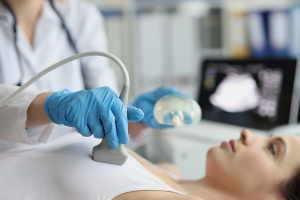Breast ultrasound may lead to unnecessary biopsies for some women
by
John R. Fischer, Senior Reporter | June 21, 2023

Breast ultrasound may be subjecting women who are not at risk for breast cancer to biopsies.
In a new study, nearly 80% of women with dense breasts underwent ultrasound, despite not being at high risk for interval invasive breast cancer, raising concerns that the modality could be subjecting patients to unnecessary, invasive biopsies.
The authors, from the University of Vermont Cancer Center, stress that breast ultrasound should only be used in women at high risk for mammography screening failure, when cancer develops following a negative mammogram, and say that breast ultrasound requires additional imaging because it also detects benign tumors, increasing recall and false positive biopsy rates.
They evaluated 38,166 supplemental ultrasound and 825,360 mammogram scans performed between 2014 and 2020 at 32 U.S. imaging facilities, according to the study, Breast cancer risk characteristics of women undergoing whole breast ultrasound screening versus mammography alone.
Among ultrasound screenings, 95.3% were performed in dense breast patients, as were 41.8% of mammograms without additional screening.
High-risk women made up 23.7% and 18.5% of patients, respectively. “Many women at low risk of breast cancer, despite having dense breasts, underwent ultrasound screening, while many other women at high risk of breast cancer underwent mammography alone with no supplemental screening,” said author Dr. Brian Sprague, of the University of Vermont Larner College of Medicine in Burlington, in a statement.
The authors recommend using risk calculators that account for age, family history, and other factors in assessments.
Dr. Stamatia Destounis, managing partner at Elizabeth Wende Breast Care, and chair of the ACR Breast Commission, told HCB News that if possible, facilities should invest in contrast-enhanced mammography or breast MR. She notes, however, that staffing limitations and expensive costs for these solutions can make this unfeasible.
"For the patients that have a small invasive cancer found only on ultrasound, this leads to earlier detection and improved prognosis. If facilities had availability to perform contrast imaging with contrast-enhanced mammography or MR, I would choose contrast imaging as it detects many more breast cancers per 1000 women imaged than breast ultrasound," she said.
The findings were published by Wiley online in Cancer, a peer-reviewed journal of the American Cancer Society.
|
|
|
You Must Be Logged In To Post A Comment
|
